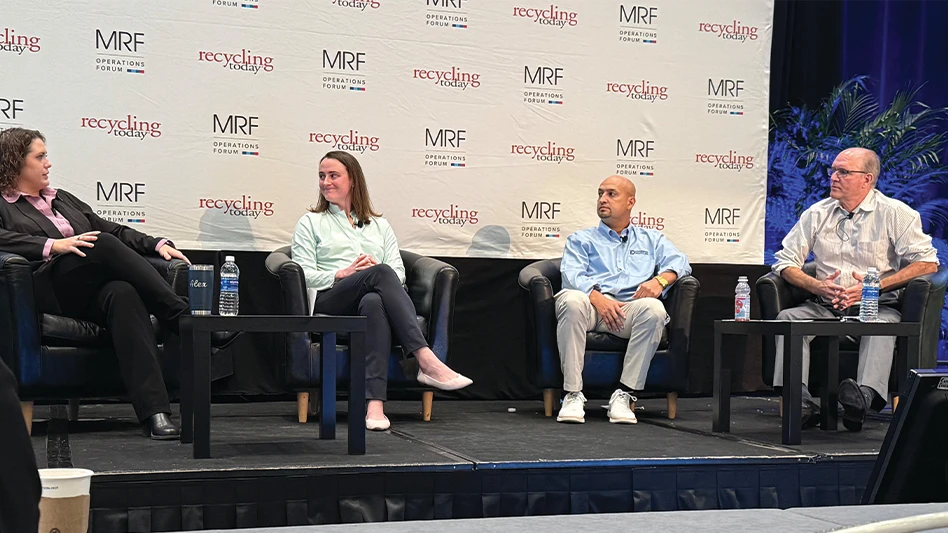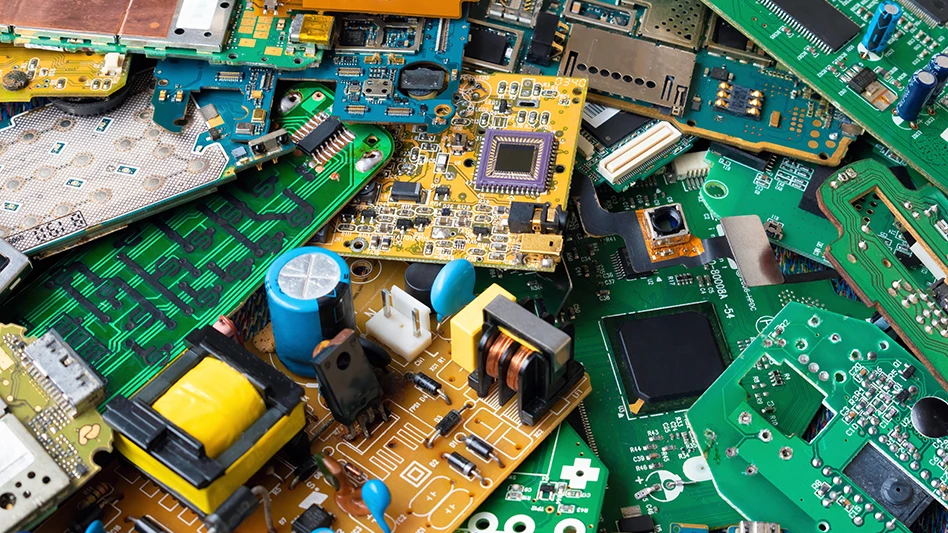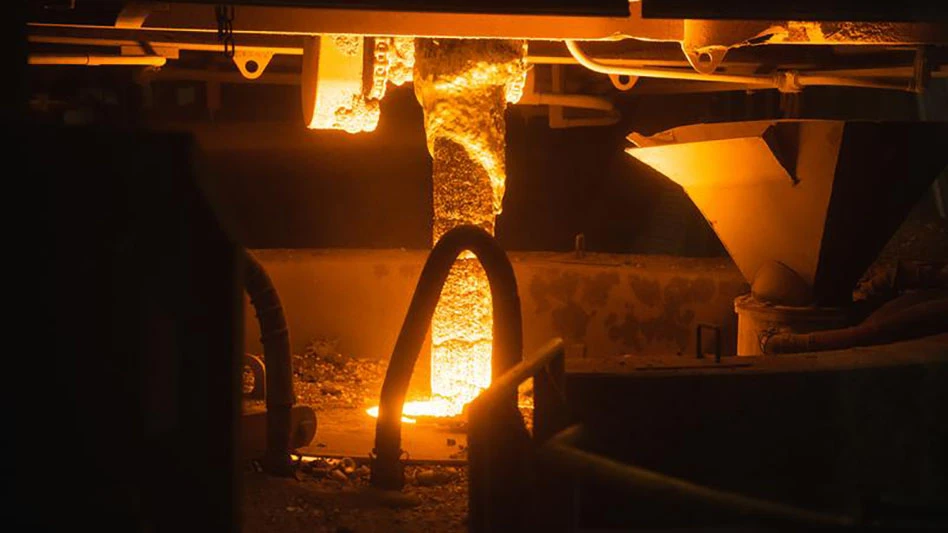
Photo by Mark Campbell Productions
In the time since optical sorters first were introduced to U.S. recycling systems, the technology has proven largely successful in increasing recovery rates and reducing the manpower needed to sort materials.
When paired with machine-learning technology using cameras and near-infrared sensors, optical sorters easily can differentiate plastic grades and other materials, giving material recovery facility (MRF) operators more control and flexibility in what they sort. In addition to higher purity rates, optical sorters that use AI also provide valuable data on material streams and system productivity.
At this year’s MRF Operations Forum, Oct. 17-18 in Chicago, panelists during the Data & System Intelligence session discussed how data are being used to improve recycling operations.
Moderator Nat Egosi, president of Melville, New York-based RRT Design & Construction, kicked off the session by asking what data truly are available to MRF operators, and the panel, which included systems providers and equipment manufacturers, indicated there is quite a bit.
Looking at the numbers
Matanya Horowitz, CEO of Louisville, Colorado-based Amp Robotics, described AI as a system capable of identifying almost every piece of material coming through a sorting line, noting the technology is incredibly specific about what it identifies.
“We have some applications where we’re counting just about everything that’s going into a bale,” he said. “You get a bale count, and you also can say this bale is … 10,000 different objects, and for each one of those contaminants, here is what they are. [Then], there’s a material characterization at the end of the line. All these are different uses for this fundamental information.”
JD Ambati, founder and CEO of Fremont, California-based EverestLabs, said analyzing material streams is just the beginning of what this technology can offer.
“From our perspective, there are dozens of data points available today,” he said. “Using AI in a material characterization is just the basic—the low-hanging fruit. … Most importantly, the data is all-encompassing information about how your plant is running.”
Ambati added that data collected using AI can help determine the efficiency of different aspects of the system, allowing operators to make changes based on overall performance.
In terms of how data could be used to make decisions within the MRF, panelists provided a host of examples, primarily surrounding equipment maintenance, material flows and bale composition.
Horowitz said he felt the most intuitive use for AI-based data is tracking equipment performance.
“Some of the most straightforward [uses] is putting it behind pieces of equipment and seeing how well that piece of equipment is working [or] if it’s degrading over time,” he said. “One interesting application we worked on with [a] site was … identifying how evenly loaded the system was.”
He explained it’s critical to ensure a system is loaded evenly, noting instances where systems can underuse capacity by 20 percent to30 percent because of mistakes on the front end or faulty equipment. System efficiency also can be driven by more insight into material flows, Horowitz said.
“I think one powerful [use] that’s not fully appreciated yet is the ability to characterize the material flow per inbound load,” he said, adding that data on material streams gives operators the ability to identify higher residuals in loads, which can pinpoint bad actors.
“We’ve seen interesting patterns where, on a weekly basis, higher concentrations of PET [polyethylene terephthalate] and things like this can lead to different system operations,” Horowitz added.
Better insight into material composition also creates opportunities for operators to drive revenue exchange.
“We’re now seeing customers … who are basically taking the outbound data, applying that to bales and are actually trading against that value,” said Thomas Brooks, chief technology officer for Eugene, Oregon-based Bulk Handling Systems. “We have one customer, in particular, doing that with fiber, [and] we have two more … looking at that with PET. Those are very specific [examples with] commercial intent that’s driven out of that data.”
Increasing ROI
Material priority on a picking line often can change given the unpredictability of recycled commodity markets. Using AI and optical sorters to identify and sort inbound loads gives operators more perspective on projected revenues and the economic value of each material, providing a baseline for what materials they should sort.
David Marcouiller, executive vice president of engineering for Canada-based Machinex spoke of a system that company installed in Michigan that loops material, with the robot deciding what to pick based on “the percentage of what it sees on the belt to go and decide to pick PET, for example.” He added, “Until the value of the PET or the amount of PET is reduced, then it will switch to the next-most-wanted material automatically.”
He added that the operator can pull this information to make decisions about where to invest in the system or how to react to a fluctuation or a malfunction.
EverestLabs, which developed the AI-enabled recovery system RecycleOS, is employing similar methods to offer recyclers financial data analysis.
“We take data from financial markets, the recycling markets … pricing guides from all regions of the county, down to every commodity level, and we pull that information into our APIs [application performance interfaces] and show the plant operator what the market value is for various commodities,” Ambati said. “So, they can use that information, or they can go ahead and input their own commodity prices that they’re getting from their own brokers.”
In an industry where every minute counts, Horowitz said seeing the data in real-time can help operators mitigate costly downtime as well as high contamination that can affect revenue.
“I think what most people are focused on is when [they’re] losing value to the residue, or when [they] are having significant quality degradation,” he said. “For instance, in fiber … if there’s an issue there, it’s going to hit my revenue, so I want to know really quickly.”
To give operators the ability to make quick decisions, Amp Robotics has employed real-time alerts, typically in the form of an email or text message, to personnel.
“By making sure that they’re fully up to date on what the plant is doing on a minute-by-minute basis, and … having suggestions for what’s going to happen, we found that to be quite powerful,” Horowitz said.
Finding the right fit
Integrating AI into an existing system can be more challenging than incorporating it into a new facility. Given the propensity for older facilities to have equipment from several different manufacturers, Marcouiller said, he often needs to work with competitors and other manufacturers to integrate software into the main control system.
“At some point, most customers will undergo [incorporating] a major overall control [system]—it can be with us, it can be with others—and that will become the main player that can actually integrate most of the information,” he said. “Just as when we supply a new MRF, each [piece] of equipment has data points that can be transferred into a SCADA [supervisory control and data acquisition] system or into the main control. If you undergo that overall [control system], you can actually centralize all of them and use those … data.”
Egosi noted that automating an older system, while possible, can become trickier and more costly, with the price of an upgrade sometimes hitting the million-dollar mark, depending on the size of the MRF.
Horowitz said Amp Robotics has prioritized making its AI system easy to retrofit to address this issue.
“I would argue that … you don’t necessarily need that physical integration to provide a lot of value, in which case, you can avoid many of these costs,” he said. “Really what we require for integration is largely an internet connection, so that information can get to the servers.
“There is, of course, much that you can do with a tight degree of integration, but our focus has been how do we make it easy to adopt for the large installation base of existing facilities,” Horowitz added
BHS has taken a similar approach to integrate AI into existing systems, with Brooks saying that the “data stream can be brought out with essentially an internet connection.” However, Brooks admitted that for a high level of autonomy, it’s necessary to have full integration.
“It’s a fairly hefty capital expense,” he said. “But at the same point, though, you’re talking about driving your business in a completely different way. So, I think a complete audit, complete automation and that highest tier requires full integration—you’ve got to have somebody doing it top to bottom.”
Latest from Recycling Today
- AF&PA releases 2023 paper recycling rate, unveils new methodology
- ARA names new president
- Aurubis invests in Lünen, Germany, site
- ILA, USMX negotiations break down
- Van Dyk hires plastics industry vet to expand footprint in PRF sector
- Li-Cycle closes $475M loan with DOE
- Report highlights consumer knowledge gaps in lithium battery recycling
- AMP names CEO





